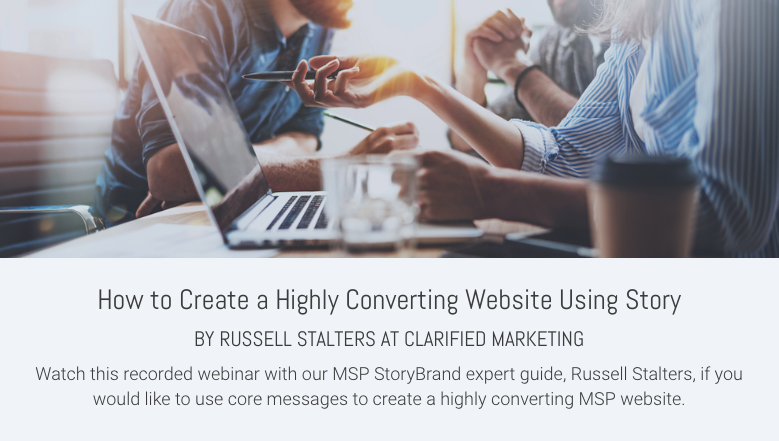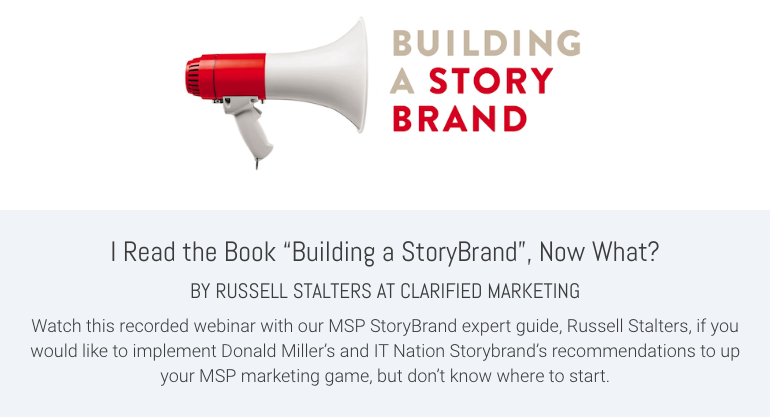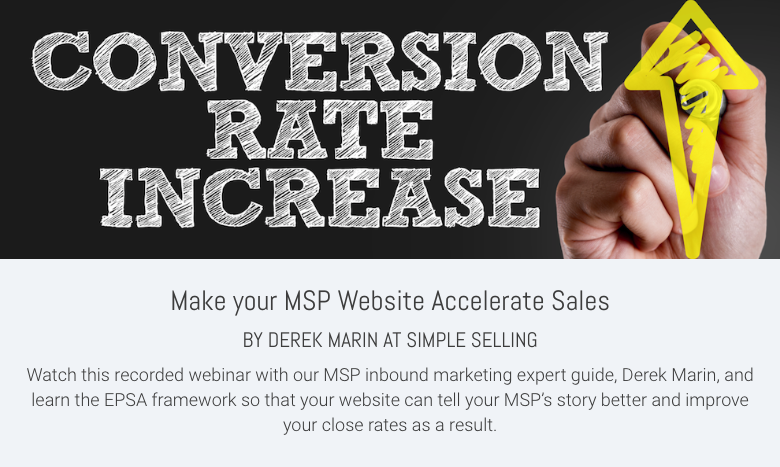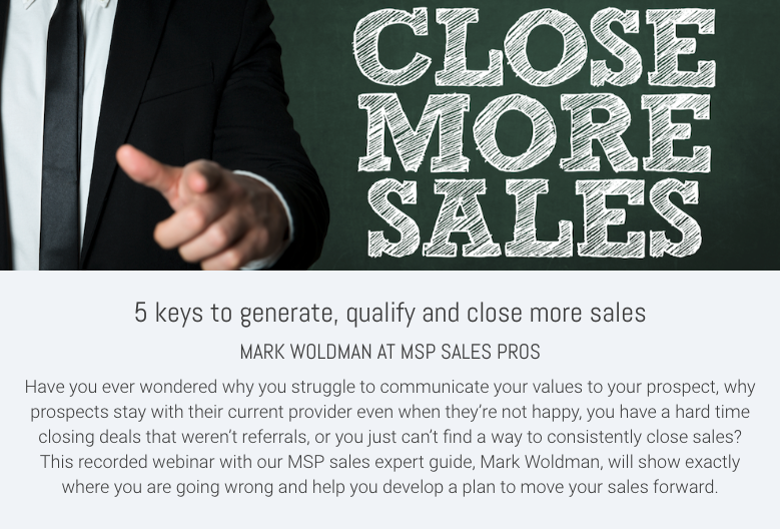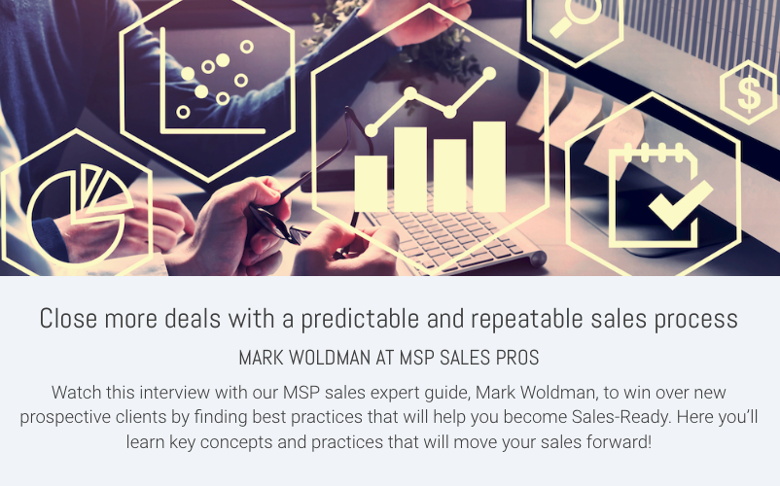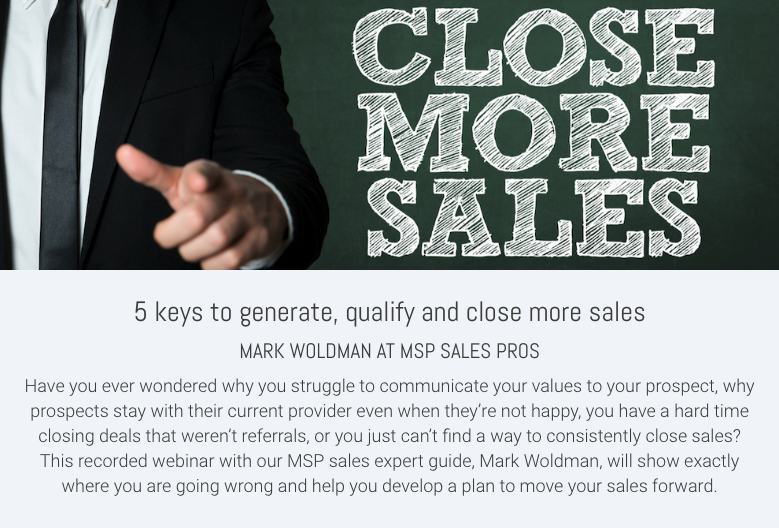Marketing Your MSP Part 2
By Adam Walter on October 25 2021
Apple Podcasts: https://apple.co/2NHRRDl
Spotify: https://spoti.fi/3AyHCUd
In our continued chat with Paul Green, we learned even more about marketing your MSPs through a three-step process. Here’s how it works.
Step one: Build multiple audiences.
Ultimately, you need people to talk to. The more people you have listening, the more likely your company will do well. Your basic audiences are your email and LinkedIn, meaning that those platforms should be given the most attention.
Other audiences could include podcasts, social media platforms and a direct mailing list — all things that you should be implementing in order to have the biggest audience and the biggest impact.
Step two: Create a relationship with your audience.
This relationship-building aspect is all about content. This content should include both education and entertainment in order to fully engage people. When we talk about educating people, it’s best to not get too technical — more low-level stuff that you can explain so any normal person can understand. This will help your audience view you as a helpful resource.
In order to build up your audience, engage with them daily, weekly and monthly. Put out relevant social media content daily. Curate this content from the mindset and eyes of the consumer. Send out a weekly email to teach your audience something that they do not know that will help them learn. Create and send out a monthly newsletter, giving your audience something to physically hold, read and pass along.
Another fun tip is to keep a dream 100 list. This list is the top 100 people you dream of working with that you actively engage and maintain relationships with.
Step three: Commercialize your audience.
This step is mostly done over the phone. It can be done by either you or someone that you know who is warm, friendly and great with people. Pick up the phone and call all of the people who you engage with, either by email, social media, direct mail and more. This isn’t a sales tactic — it’s a chance to talk to people about what they love to chat about most: themselves.
Human relationships are very important so using this three-step process will ensure you create and maintain great relationships with your audience and ensure success for your MSP.
Market Your MSP (Part 1)
By Adam Walter on October 18 2021
Apple Podcasts: https://apple.co/2NHRRDl
Spotify: https://spoti.fi/3AyHCUd
MSPs can easily talk to each other about the latest gadgets and gizmos, but talking to other people about that same technology can be more of a struggle. It is the same with MSPs and their conversations with businesses.
Watching someone try to sell their services to people can be like watching a slow-moving train wreck — there is enthusiasm when MSPs talk to business owners, but it can be hard to translate that excitement to the client.
That is where the importance of conversations comes into play.
If you’re an MSP, then your entire training for becoming an MSP has been technical. You learned the tips and tricks and workarounds for all things technology. Now, all of a sudden, you are being asked to work with people and explain your services and abilities to them. You most likely do not have the training or knowledge to have conversations that will enable those business professionals to fully understand what it is that you do and what you can do for them.
When entering those conversations, it is important to approach them as people and not as machines. You cannot simply throw solutions their way expecting them to grasp what it is that you are trying to tell them. You have to listen — find common ground and really understand what it is that they care about.
If you are only talking about technology, it will most likely make their eyes glaze over and feel impersonal. At the selling stage, business professionals do not care about the technology — they care about whether they like you or not. Look at the technology solution through their eyes. See how this technology can truly help them, not from an IT standpoint, but from a personal perspective.
Here’s an example. An MSP makes a business’s internet speed much faster and its bandwidth much better. The MSP will look at this solution as a complete technical solution. But, the business professional is excited about having extra time due to not having to actually drive into the office, letting them attend their daughter’s softball game. Both people had totally different standards to measure success, but both situations were using the same technology.
Ultimately, people make most decisions with their hearts, not their heads. If you are great at connecting with the person before talking business, then selling to them will be much better for both parties.
How Do I Get Visitors to Engage with My Website?
By Russell Stalters on October 8 2019
How to Do I Get Visitors to Engage with My Website?
I mentioned this in my last Blog post. We live in a very “noisy” world and we need to grab their attention in less than a couple of seconds.
This is true for our website too. People don’t read website content any longer. When someone lands on your homepage they will start skimming the page very quickly to decide if they want to spend more time diving deeper.
“But, they went to my page because we met at a networking event!”
It doesn’t matter.
You have 5-8 seconds to capture their attention. Studies have shown that on a computer web browser people scan the webpage in a Z pattern. Left to right across the top, then down to the lower left and across the bottom of the page before they start scrolling down. We call this area before they scroll down “above the fold” which is an old newspaper term.

So, how do we grab their attention?
When they land on the homepage we have to instantly answer three questions…
- What is the big problem you solve?
- What will my life look like after I buy your product or service?
- How do I buy? or What is the first step in the sales process.
Once we have them hooked and our visitor decides to scroll down we need to tell a story.
Not our story or the story of our company. We need to invite them into their story. A story of transformation.
One of the best ways to create your customer’s story of transformation is to use the StoryBrand methodology as described in Donald Miller’s book “Building a StoryBrand: Clarify Your Message So Customers Will Listen”. As a StoryBrand Guide I help MSPs implement the StoryBrand methodology to attract their ideal clients, get more meetings, and grow their business.
During this session I will provide a blueprint for creating a highly converting website homepage. He will share best practices on how to implement the recommendations from the great book, “Building a StoryBrand”.
I will also provide live feedback and improvement recommendations for attendee’s websites during the webinar.
So, make sure you register here and be ready to get feedback on your website.
How to Make Managed Service Provider Marketing Better
By Russell Stalters on September 11 2019
Here are two ways to make your making better.
Managed Service Providers (MSPs) most often have really complex solutions. One challenge most people in the IT industry suffer is the “curse of knowledge”. The term was coined by Chip and Dan Heath back in 2006 and then they wrote about it in their 2007 book, “Made to Stick: Why Some Ideas Survive and Others Die”. Later, Lee Lefever described practical ways to combat the “curse of knowledge” in his book “The Art of Explanation: Making your Ideas, Products, and Services Easier to Understand”. I highly recommend both of these books to anyone who is marketing and selling IT solutions.
With the curse of knowledge, we know our product or service so well we have a difficult time imagining what it is like to not know it. This seems to be especially true with technical fields and IT professionals. Our technical and inside knowledge interferes with our ability to see the world from another person’s perspective. We wind up talking over the heads of our customers.
Remember we live in a very “noisy” world and we need to grab their attention in less than a couple of seconds. This is an area that many of my clients struggle with.
On a scale of 1 to 10, where 10 is the complexity we as MSPs live day in and day out, and where 1 is super simple, we need to be at a 2 or 3. Most of my clients have their marketing “dumbed down” to a 7 or 8 and our customers will be attracted to and understand messages that are at a 2 or 3. The good news is that after you work on simplifying the way you talk about your solution to your customer’s problem, customers will listen.
We live in a very distracting world. One of the other ways to cut through the noise is through story. Think about it. Until the printing press and the proliferation of books, story was the primary method of communication and passing on information. Story helps cut through the noise by organizing information in a way people will listen. Facts, figures, and features are boring.
Neuroscientists estimate humans spend more than 30% of their time daydreaming. Think about the last time you watched a great movie with a great story – were you daydreaming? We can use story to help our customers see how we can solve their problem and what their life will look like after they buy our product or service.
A list of features or benefits by themselves will not sell your services. Use a story of a customer’s journey from frustration and challenge to success with your solution and services. Every person intuitively understands a good story and is working at living her own story. If your business could understand the story your customers are living in relationship to your brand, you can stop selling products and services and instead invite customers into a story. Their Story. By positioning your company as the guide in your customer’s story, you can more easily speak to your customer’s needs.
One of the best ways to create your customer’s story is to use the StoryBrand methodology as described in Donald Miller’s book “Building a StoryBrand: Clarify Your Message So Customers Will Listen”. As a StoryBrand Guide I help MSPs implement the StoryBrand methodology to attract their ideal clients, get more meetings, and grow their business.
Make Your MSP Blog a IT Sales Tool
By Derek Marin on September 6 2019
Okay, you just exchanged business cards with the owner of an accounting firm during a chamber event.
He said, “Sure, let’s plan on meeting some time over the next 2 weeks.”
Awesome! You left the event with a qualified lead! Plus, he agreed to meet and he already shook your hand.
The problem, because we all know it’s never that easy, is that there’s a delay. You couldn’t ask him much of anything, and nevermind describing what makes your MSP unique.
There’s no set date for the appointment, and who knows, he may bump into a competitor or research online in the next 10 days!
So, what do we do now?
You need to activate the EPSA campaign
EPSA is an acronym for education, professionalism, story-telling and authenticity, and together, these are the qualities you want your prospect to understand, because if they grasp what makes you and your company unique, your chances of winning will go up.

The full implementation of EPSA is what I’ll cover in the seminar, but for this blog, I’ll share just two examples of how MSPs are doing the “E for education” part of the EPSA methodology.
E is for Education
Let’s get back to the story above.
The CEO of that accounting firm may have asked you a question about security, or maybe they told you they were using O365 but not getting much out of it, or perhaps he didn’t say a thing aside from “we need help with IT.”
The goal with the E part, or “education,” is to teach your qualified opportunity two things. First, to teach him something he didn’t know, and second, to show him that your company is a thought-leader.
Example by NSI

NSI is an MSP in Naugatuck, CT, that my agency helps with sales and marketing. A blog called, “In the Trenches of a Real Breach” is an audio interview we did with Tom McDonald, the CEO, about some ransomware attacks. It goes into what a SOC is and the importance of having an incident response plan. By having Tom’s voice and real story, we are showing his unique expertise.
Example by Casserly Consulting
Casserly Consulting is an MSP in Boston. A blog called, “The State of Cyber Security in the Commonwealth” we took the publicly available breach data from Mass.gov and we analyzed it. By doing a deep dive into the nature of breaches in Massachusetts, we’re making Peter’s MSP a thought-leader.
Cold calling best practices with Carrie Simpson
By Denes Purnhauser on October 1 2015
Carrie Simpson, Founder and CEO of Managed Sales Pros is the one and only MSP Cold Calling guru- an expert on what drives tangible results. Though we are very much focused on the inbound marketing side of lead generation, we cannot deny the potential performance of cold calling.
I was really interested in her best practices in getting leads over the phone, and surprised by some of the hints and tips Carrie shared with me. She talks on how to overcome call reluctance, how to build a winning script, and how to best manage the time investment.
Differentiate yourself from your competition and
become sales ready
If you have not done cold calling before, or you think your approach isn’t working, just listen and learn how you can fill your sales pipeline. Mixing the MSP 2.0 message with cold calling can build your revenue funnel faster.
START GROWING WITH MSP SALES RELATED RESOURCES FOR FREE
5 KEYS TO GENERATE, QUALIFY AND CLOSE MORE SALES
Have you ever wondered why you struggle to communicate your values to your prospect, why prospects stay with their current provider even when they’re not happy, you have a hard time closing deals that weren’t referrals, or you just can’t find a way to consistently close sales? This recorded webinar with our MSP sales expert guide, Mark Woldman, will show exactly where you are going wrong and help you develop a plan to move your sales forward.
CLOSE MORE DEALS WITH A PREDICTABLE AND REPEATABLE MSP SALES PROCESS
Watch this interview with our MSP sales expert guide, Mark Woldman, to win over new prospective clients by finding best practices that will help your MSP become Sales-Ready. Here you’ll learn key concepts and practices that will move your sales forward!
How to turn an unknown visitor into a lead easier than you thought
By Denes Purnhauser on September 4 2015
We’ve been talking about the 4+1 Website Sins Preventing MSPs from getting more MSP leads. Many of you are asking, "Okay. I know our MSP website doesn’t generate leads like we wish it did, but we don’t have the money and time to re-work it, so what do you suggest?"
Here we describe a process to add elements to your current MSP website in under 60 minutes and generate leads.
Before we start let's get perspective on the situation. If your current website does not have enough visitors, it’s hard to make any magic happen. If your current website attracts visitors, but they’re not qualified, then you’re still not generating the leads you need.
If you aren’t sure send me an email with your website URL. We’ll run an analysis on your website, and report how many leads you can expect by implementing this process.
The idea here is to create a lead-generation process that attracts the right visitors through social media, organic searches, and so on.
We are going to use our platform to demonstrate this method in practice. The process is general - you can use any marketing software to implement it. The difference among them will be the time, difficulty of implementation and the creation of the content.
Win new clients with it sales software
Step 1: Pick two Graders from the MSP marketing library
First, we need something interesting and relevant to the visitor so they can get engaged. We should use something on the main page or a landing page where they can do something interactively.
Graders are mini-surveys which can be implemented on any website. The visitor clicks on the Call to Action button and a javascript pop-up window appears. Here the visitor gets yes-or-no type questions on a particular topic. Based on their answers, it sends back a Grade - a score for the visitor (whoops...it's now a lead.) in a nicely packaged ebook format. It comprises their score, some suggestions, advice, next steps, and more information.
Although Graders can be modified and created from scratch, we have a bunch of them that can be implemented quickly. A Productivity Grader for example asks 7-8 questions about how a visitor leverages technology to become more productive - about emailing habits, meeting organization, personal task management, team project management and so on. At the end they get back a Productivity score. You as an IT managed services provider can influence their productivity, so you need to engage them in conversation about the value and benefit of your services. That's what we call "business communication."
These little Graders are great in social media as they spread quickly and also help us to qualify our leads. There are popular Graders such as measuring your current service provider. Whoever is evaluating the current or future provider will be highly likely to fill out our Grader, because they are already looking for the answers in the results.
The MSP 2.0 Marketing platform gives you quite a bit of flexibility on the content and function of Graders. It sends a white label pdf with your logo from your email, and also an email sequence to follow the lead after sign up.
We have not seen any other complete software for these things. Surely Wufoo, Surveymonkey or Google forms can get the answers, but would require a lot of manual processing to create the report, and won’t have the content and design.
Step 2. Pick Two MSP eBooks from the library
There are of course people who do not want to play with the tools, but do like to download valuable content. Based on our research, if content is business rather than IT oriented, the conversion rate from visitor to lead is higher. For example, if we write an MSP eBook entitled: "How smart executives boost their top line with sales intelligence," rather than: "Should you Implement Windows 10?", we get much better lead generation.
The eBook will highlight the benefits of applications and technology solutions that smart executives use and the visitor doesn’t yet. Since the eBook is written for executives, executives will and office managers will not download them. That helps you qualify the leads.
Our MSP marketing library has plenty of different eBooks you can implement quickly. The docx format is easily customizable with your logo and your name, and then ready to go.

A good eBook increases the conversion, but a great eBook increases visitors as well. Social media is ideal to promote such content.
Then again you may want to create your own content, which is great. As we see it, to create an eBook or Grader takes at least 1-2 months for a busy managed services provider. We usually suggest choosing generic eBooks and Graders first from the library. After swapping out the titles every one or two weeks and checking the statistics to see which works better, then you can add your content, but without losing the 1-2 months of lead generation opportunity.
Step 3. Implement Calls to Action
Now that we have some content to offer we should help the visitors to take action.
We use four types of call to actions (we call them Lead Magnets).
- Button - to place inside our current text with a javascript code
- Pop Over - to create more attention
- Scroll Box - to offer our material when they scroll down our page
- Smart Bar - to make a short offering on the top of the page
We then need to configure these Lead Magnets accordingly. We can modify the page they appear on, the type, whether it shows every visit or day or week, etc. Nobody can accurately predict what works best for everybody, so just set it up and tweak it based on the feedback reports.
These reports show you how many times the Lead Magnet appeared, on which pages, what the visitor did, etc. so you can best tweak the size, color and message on the magnets.
Most marketing software has some solution for the Calls to Action, but not the reports, statistics and easy implementation and adjustment.
Conclusion:
We do not need a IT marketing assistant, marketing team, or an outsourced marketing provider to get results. This is not a comprehensive marketing system, just a reliable system to turn people into leads likely interested in our products and services, and a real chance for them to engage comfortably. Let's get busy and make business happen.
What the heck is the MSP marketing funnel?
By Myles Olson on June 12 2015

Denes and Myles discuss the top, middle and bottom of the MSP marketing funnel and how it relates to the buyer's journey through your marketing process. Understand what type of marketing works at the different levels. Follow these steps to learn how to define your buyer-personas so your marketing efforts directly target your ideal customers.
START GROWING WITH MSP MARKETING RELATED RESOURCES FOR FREE
Demand generation with funnel websites
BY DEREK MARIN AT SIMPLE SELLING
Watch this interview with our MSP inbound marketing guide, Derek Marin, to win over new prospective clients by finding best practices that will transform your website into a tool that shortens sales cycles and increases close rates.
Why inbound marketing works for MSPs
By Myles Olson on October 27 2014
Let’s begin with what makes inbound marketing great in general. It draws your target audience to you, so you don’t have to go to them. You become a trusted authority on your subject matter in your market. The concept is simple but there are some key points I see people often overlook.
First and most important to remember when you’re building your inbound marketing campaign is that you need to be continually adding to the content your audience is looking for. Your MSP’s clients are out there right now trying to find ways to make their businesses more efficient for less money.
If you’re not providing them the information they’re looking for, your competition will. Even if they aren’t actively shopping around for your services they are seeing articles, blog posting, and comments on their social media feeds. There’s a good chance you’re reading this right now because you saw it in your LinkedIn news feed. This is how inbound works..
We at Managed Services Platform feel that you should be speaking to the C-level executives who have the authority to buy your services. They probably care about virtualization about as much as they care what brand of light bulbs are in their office (not much). They only care how their business can make more money and expend less doing it.
Let’s make sure we construct our content with that in mind. We’ve ditched the sales pitch, now we’re ditching the tech talk. Here’s a great example: The MSP 2.0 Service Offering in the 7C IT Management Framework. See how that provides lots of great insight a CEO could be interested in? Did you notice the most important part at the end? The often overlooked Call To Action!
If consistent quality tailored content is the first thing to remember for inbound, having a great call to action is the last. Everything else fits in between. Always think “where is my reader going next?” This is known as the buyer’s journey. Let’s define our buyer, then provide them a road map to not only finding us, but to find out what’s distinct about us, and hence to buying our services.
Follow these steps to be sure your inbound campaign is working:
- Define your ideal client. Often your business will have several. Usually they are a CEO, CFO, CIO or COO. They have the purchasing authority to buy your services. Write content that speaks to them.
- Define how they will go from finding your to buying from you. A typical buyer journey goes something like this: they see and choose to read an interesting article you published on linkedIn, then follow your call to action and subscribe to your blog. A few blog posts down the road they follow another call to action and download a checklist. This generates an email from you offering a complimentary report on their IT competitiveness quotient. Now you get to show them how your MSP can give them a competitive advantage in their market. You just found a new customer.
- Create and distribute great content with blogs, emails, social posts, infographics, quality landing pages and a responsive website.
- Always have a call to action that moves the viewer along the journey as you defined it.



